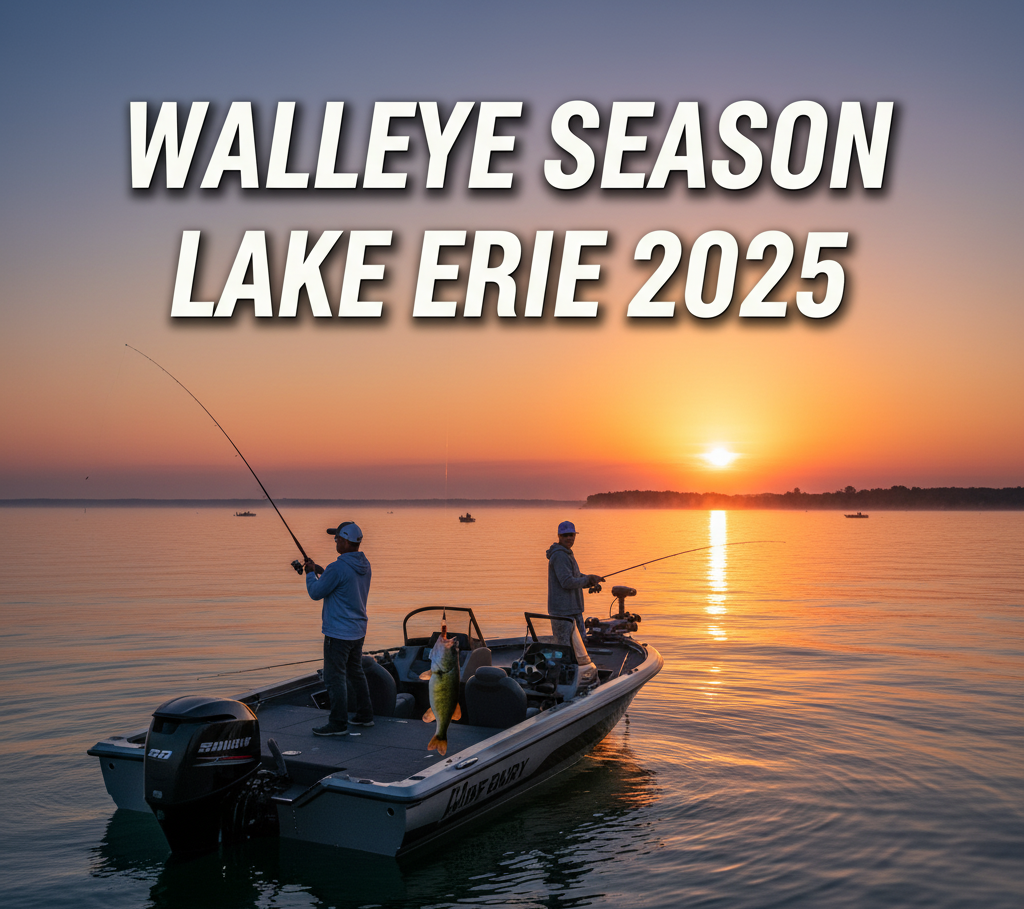
If you love fishing, you already know that few places can match Lake Erie, especially when it comes to walleye. Known far and wide as the Walleye Capital of the World, this Great Lake has earned that title with good reason. Year after year, it continues to deliver both quantity and quality, producing trophy-sized fish that keep anglers coming back.
As we roll into walleye season 2025, excitement is building. Many anglers have already started tuning up their gear, checking weather patterns, and planning weekend trips. Whether this will be your first visit to Lake Erie or it’s an annual tradition, knowing when to go, where to fish, and how to adapt your techniques can be the difference between an okay day and an unforgettable one.
Let’s break down everything you need to know for a successful walleye season on Lake Erie in 2025, with helpful, real-world tips to help you catch more fish and enjoy the experience from start to finish.
When Is Walleye Season on Lake Erie?
You can target walleye on Lake Erie nearly all year, but the prime fishing window stretches from early spring through late fall. Each season brings its own conditions, challenges, and rewards. Understanding how walleye behave during these periods can help you plan your trip more strategically.
Spring (April – June): The Trophy Season
Spring is what many anglers call the trophy window. As the ice melts and water temperatures hit 40–50°F, walleye move into shallow waters and tributaries to spawn. This is when those legendary 8–10 pounders start showing up in photos all over social media.
It’s commonly known that the western basin is where the magic happens early in the year, especially around Maumee River, Sandusky Bay, and Port Clinton. Many anglers drift or anchor near rocky structures, working soft plastics or hair jigs slowly along the bottom. When you find them, the bite can get fast and furious.
Pro Tip: Focus your early-season trips in the western basin before the fish migrate east. In murky water, try bright jigs like chartreuse or pink. Once the water clears, switch to natural colors like olive, brown, or white for a more subtle presentation.
Summer (July – August): The Migration Months
By midsummer, the lake warms up and the walleye begin migrating eastward into deeper, cooler water. This is when trolling becomes the go-to strategy. A lot of beginners struggle with trolling at first because it’s a balance of speed, lure depth, and location, but once you get it right, it’s one of the most effective ways to catch big numbers.
Most anglers rely on crawler harnesses, crankbaits, and planer boards to cover large sections of the lake. The central basin, stretching from Lorain to Geneva-on-the-Lake, becomes the prime zone in July. Later in the season, the hot action shifts toward Erie, Pennsylvania, and Buffalo, New York as schools push east.
Expert Tip: Watch your sonar closely since walleye often suspend between 30–60 feet deep while chasing baitfish. Adjust your trolling depth throughout the day as the fish move. Many experienced anglers keep detailed notes to track depth patterns year over year.
Fall (September – November): The Feeding Frenzy
As the air cools and the leaves start to change, Lake Erie’s walleye go on a serious feeding spree. Many locals say this is their favorite time of year because the fish are aggressive, the crowds are smaller, and the weather when it behaves is perfect for calm, quiet mornings on the lake.
You’ll find fish stacked near drop-offs, reefs, and rocky shorelines, feeding heavily on emerald shiners and shad. Crankbaits and vertical jigging shine here, especially in 20–40 feet of water.
Local Insight: The fall bite often continues well into November if the weather stays mild. Some of the best days happen when the lake is glassy calm and the air is crisp. Bring a thermos of coffee, layer up, and soak it in it’s one of the most peaceful fishing experiences you’ll ever have.
Best Spots for Walleye Fishing on Lake Erie
Lake Erie spans more than 240 miles, and each basin offers a different experience. Many anglers rotate through multiple areas during the season, following the migration and adapting to changing conditions.
Western Basin – Port Clinton & Maumee Bay
This shallow, warm region heats up first in spring and kicks off the action. It’s ideal for jigging and drifting and has long been known as the heart of the walleye spawn.
Central Basin – Lorain to Conneaut
By summer, the fish head deeper and this basin becomes trolling heaven. Use planer boards, dipsy divers, and crankbaits to chase suspended fish.
Eastern Basin – Erie, PA to Buffalo, NY
Late summer through fall, this zone lights up with big schools and even bigger fish. It’s a mix of structure and open-water trolling, perfect for anglers who love exploring different depths and conditions.
Charter Tip: If you’re new to Lake Erie, consider booking a local walleye charter. Many visitors underestimate how big and unpredictable this lake can be. Local captains not only know where the fish are but also help you stay safe and maximize your time on the water.
Gear and Techniques That Work Best
Having the right setup is key. Walleye can be finicky, and little details often make the difference between catching a few and filling your cooler.
Rods and Reels
- Medium-light to medium-action rods (6’6”–7’6”)
- Smooth, reliable spinning or baitcasting reels
- 10–15 lb braided line with a fluorocarbon leader
Top Lures and Baits
- Spring: Jigs with soft plastic tails or hair jigs
- Summer: Crawler harnesses with live nightcrawlers for trolling
- Fall: Deep-diving crankbaits and stickbaits for aggressive fish
- All year: Blade baits and spoons for vertical jigging
Trolling Tips
- Keep speeds between 1.5–2.5 mph
- Use snap weights or lead-core line to hit deeper zones
- Don’t stick to one color; walleye moods change fast, so switch up presentations if the bite slows
Understanding Walleye Behaviour
Walleye are clever predators. They prefer low-light conditions, feeding most actively at dawn, dusk, or during cloudy, windy days when the water gets a little murky. Many anglers find that overcast days, which some people avoid, actually produce their best bites.
At night, walleye move closer to shore. Casting from the bank or near shallow reefs under moonlight can be incredibly productive, especially for those who enjoy a quieter, more relaxed fishing style.
Safety and Regulations for 2025
Before you hit the water, make sure you’re up to date with local regulations.
- Fishing License: Always carry a valid license for Ohio, Pennsylvania, or New York, depending on where you launch.
- Bag Limits: The 2025 daily limit is expected to stay around six walleye per angler, but check for updates before your trip.
- Boating Safety: Weather on Erie can change in a heartbeat. Wear a life jacket, monitor forecasts, and always let someone know your float plan.
Sustainable Fishing Practices
Lake Erie’s walleye population has made an incredible comeback thanks to responsible angling. Here’s how to help keep it that way:
- Release smaller fish so they can grow and spawn.
- Avoid high-grading and don’t toss back fish that might not survive.
- Dispose of fishing line and plastic properly.
- Be respectful of other anglers and local wildlife.
It’s commonly said that good fishing isn’t just about catching; it’s about preserving. Keeping the lake clean and healthy ensures there’s plenty of walleye for years to come.
Conclusion: Why 2025 Is the Year to Fish Lake Erie
If you’ve been on the fence about scheduling a Lake Erie walleye trip, now is perfect time. 2025 is on track to be one the greatest seasons ever. The fishery has remained healthy, and the catch rates steady, and the beauty of the lake never fails.
Chasing giants in spring, trolling deep in the summer or battling aggressive fall feeders there’s something special about every part of the season. So, get your gear, call up a friend and make it happen.
So, when it is time for walleye season on Lake Erie and you get an opportunity to visit, then you will see why so many people refer to it as their Favorite fishing destination in the world.
Plan Your Next Adventure
To think less about logistics and fish more, book a local charter. Professional guides are versed in where the fish are biting and can make your trip more enjoyable, by maximizing your catch.
One of the great options to start with is Sir Walleye Charters. They are the authority on enjoyable, safe and productive Lake Erie walleye fishing. It’s an excellent way to extend your time on the water no matter if you are just beginning or a seasoned fisherman.



